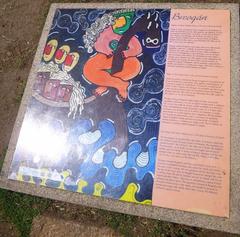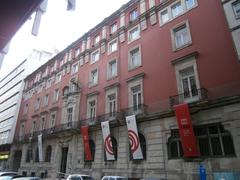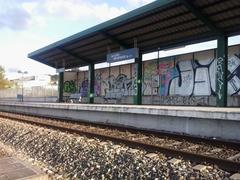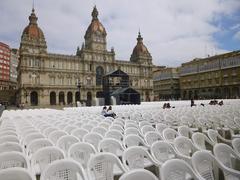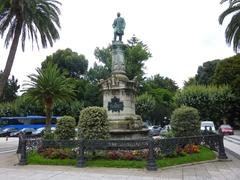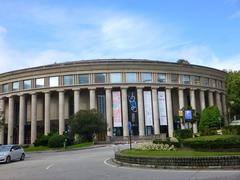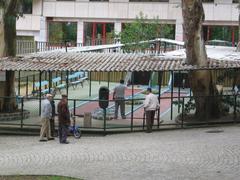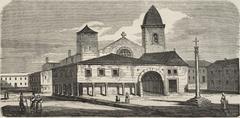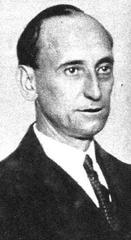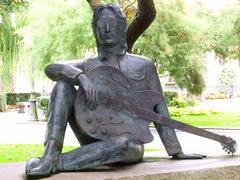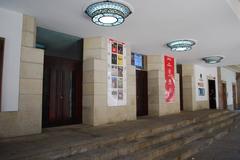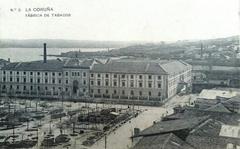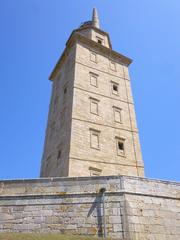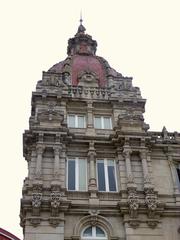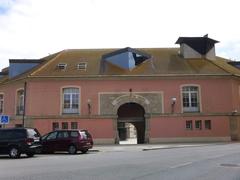Faro de Oza: Visiting Hours, Tickets, and Comprehensive Travel Guide to A Coruña’s Historic Lighthouse
Date: 04/07/2025
Introduction
Perched atop the rugged Atlantic coastline of A Coruña, Spain, the Faro de Oza stands as a testament to the city’s enduring maritime spirit and architectural legacy. This lighthouse, constructed in the early 20th century on the remnants of a 16th-century coastal battery, has guided mariners, witnessed the city’s transformation, and today serves as a cherished community landmark. Offering panoramic ocean views and a unique blend of history, culture, and scenic tranquility, Faro de Oza is an essential stop for travelers seeking to experience the authentic maritime heart of Galicia.
This guide delivers detailed insights into the Faro de Oza’s origins, architectural evolution, cultural significance, and practical visitor information—including up-to-date visiting hours, ticket policies, accessibility, and recommendations for nearby attractions. Whether you are a history enthusiast, photographer, or casual explorer, this article will equip you with everything needed for a memorable visit.
Table of Contents
- Introduction
- Historical Origins and Evolution
- Architectural Features
- Maritime and Local Significance
- Visiting Hours, Tickets, and Accessibility
- Community Use, Events, and Transformations
- Cultural Importance and Visitor Experience
- Practical Tips and Nearby Attractions
- Frequently Asked Questions (FAQ)
- Conclusion
- Sources
Historical Origins and Evolution
Early Development
The Faro de Oza’s story is deeply intertwined with the urban evolution of A Coruña. Originally, the Oza area was renowned for its agricultural lands, supplying the city with produce such as strawberries and market garden vegetables (Escapalandia). As A Coruña expanded in the late 19th and early 20th centuries, Oza transitioned from rural parish to urban neighborhood and was eventually incorporated into the city.
The need for improved maritime safety—driven by increased commercial and naval activity—led to the construction of the Faro de Oza. While the iconic Tower of Hercules was the main lighthouse for Atlantic navigation, Faro de Oza provided vital guidance for ships entering the inner harbor, marking treacherous approaches and complementing the region’s network of beacons (Spain.info).
Site Heritage
Faro de Oza occupies a site once defended by the Forte de Oza, a 16th- and 17th-century star-shaped coastal battery built after the 1589 attack by Sir Francis Drake (Waymarking). The lighthouse thus bridges centuries of coastal defense and navigation, representing both the city’s strategic importance and its resilience.
Architectural Features
Typology and Design
The Faro de Oza reflects early 20th-century Spanish lighthouse architecture with practical, understated elegance. The building integrates a modest cylindrical lantern tower with two symmetrical residential and operational wings, forming an “eclectic” structure within a single envelope (Historia de Galicia).
Key Features
- Central Lantern Tower: Houses the light, rising above the roofline.
- Flanking Wings: Provide living quarters and operational space, creating a balanced silhouette.
- Materials: Locally quarried granite for window surrounds and string courses, whitewashed masonry walls, and steel and glass for the lantern.
- 1932 Upgrade: Addition of a steel tower and a more powerful lantern to improve navigational range (Waymarking).
- Construction Timeline: Built between 1908 and 1915, inaugurated in 1917, with major upgrades in 1932 (Wikipedia).
The lighthouse’s sober design and use of local materials harmonize it with the Galician coastal landscape while ensuring durability.
Maritime and Local Significance
Navigational Role
Faro de Oza was instrumental in ensuring the safety of vessels approaching A Coruña’s bustling port, especially during the city’s industrial expansion in the early 20th century. Its light functioned as a secondary navigational aid, marking the entrance to the inner harbor and complementing the radiant beam of the Tower of Hercules. In often foggy, storm-prone conditions, the Oza light helped prevent maritime accidents and facilitated the city’s commercial and fishing prosperity (Spain.info).
Community Landmark
Beyond its technical duties, Faro de Oza quickly became a symbol of the local neighborhood’s connection to the sea. The adjoining Playa de Oza, once known as Playa del Lazareto, was historically significant for its quarantine facilities, emphasizing the site’s dual role in both maritime safety and public health.
By the 1960s, advances in technology led to the decommissioning of many smaller lighthouses, and Faro de Oza transitioned to a new life as a community space (Escapalandia).
Visiting Hours, Tickets, and Accessibility
Visiting Hours
- General Access: Faro de Oza operates as a public community venue (TEU - Espazo de Uso Cidadán) and is generally open for reservations from 9:00 to 22:00 daily, except December 24, 25, 31, and January 1 and 6.
- Casual Visits: The exterior and park areas are freely accessible during daylight hours. For interior access or event participation, prior reservation is required (Concello da Coruña).
Tickets and Reservations
- Entry Fee: There is no general admission fee for visiting the lighthouse grounds. Reservations for private or community events are free for registered residents of A Coruña.
- Booking Process: Use the Cita Previa system to check availability and reserve the space 15–60 days in advance.
Accessibility
- Mobility: The site is partially accessible for visitors with reduced mobility, though some terrain is uneven.
- Facilities: Restrooms are available during reserved events; the site is suitable for small workshops and gatherings.
Getting There
- By Car: Free parking at Oza port area, followed by a short walk.
- By Public Transport: City buses connect the Oza neighborhood with central A Coruña (Audiala).
- On Foot/Bicycle: The coastal promenade offers a scenic approach.
Community Use, Events, and Transformations
The transformation of Faro de Oza from an operational lighthouse to a community venue reflects the broader urbanization of the Oza district and A Coruña. Since 2010, the opening of Parque de Oza and the adaptive reuse of the lighthouse have revitalized the area, making it a hub for neighborhood events, meetings, and cultural activities (Escapalandia). The site’s maximum occupancy is 50 people, and all events must conclude by 22:00.
Cultural Importance and Visitor Experience
Faro de Oza is celebrated not only for its practical role in navigation but also as a symbol of local identity. It embodies the city’s connection to the Atlantic, resilience in the face of change, and the integration of historic structures into contemporary community life. The lighthouse’s understated elegance, panoramic views, and integration with the Ruta de los Faros coastal trail make it a favorite spot for reflection, photography, and cultural exploration (Holly Hits the Road).
Practical Tips and Nearby Attractions
- Best Views: Sunrise and sunset offer exceptional photo opportunities from Playa de Oza and the lighthouse promontory.
- Nearby Sites: Explore Playa de Oza, the remnants of Forte de Oza, the Tower of Hercules, Castillo de San Antón, and the Aquarium Finisterrae.
- Weather: Galicia’s Atlantic climate is variable; bring a light jacket year-round.
- Local Customs: Spanish and Galician are spoken; English is understood in tourist areas.
Frequently Asked Questions (FAQ)
Q: What are the Faro de Oza visiting hours?
A: The site is open for reservation and events from 9:00 to 22:00 daily, except for specified holidays. Exterior areas are accessible during daylight hours. (Concello da Coruña)
Q: Is there an entrance fee or ticket required?
A: No, access to the grounds is free. Reservations for private events are free for registered residents.
Q: How do I reserve the lighthouse for an event?
A: Use the Cita Previa system online 15–60 days in advance.
Q: Is Faro de Oza accessible to visitors with reduced mobility?
A: The grounds are partially accessible; some uneven terrain may require assistance.
Q: Are guided tours available?
A: Guided tours are not regularly scheduled, but special events may include them. Check official sources for updates.
Conclusion
Faro de Oza stands as a living reminder of A Coruña’s maritime roots, architectural heritage, and vibrant community spirit. Its modest yet enduring presence on the coast invites visitors to explore the rich interplay between past and present. Whether attending a cultural event, enjoying the sweeping Atlantic views, or tracing the footsteps of mariners and locals, Faro de Oza offers a unique and rewarding experience.
For up-to-date visiting hours, event information, and reservations, consult the official Concello da Coruña page and use the Audiala app for cultural navigation. Make the most of your visit by exploring neighboring landmarks along the Ruta de los Faros and immersing yourself in the maritime legacy of A Coruña.


